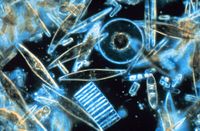
Photo from wikipedia
Abstract Human-driven changes affect nutrient inputs, oxygen solubility, and the hydrodynamics of lakes, which affect biogeochemical cycles mediated by microbial communities. However, information on the succession of microbes involved in… Click to show full abstract
Abstract Human-driven changes affect nutrient inputs, oxygen solubility, and the hydrodynamics of lakes, which affect biogeochemical cycles mediated by microbial communities. However, information on the succession of microbes involved in nitrogen cycling in seasonally stratified lakes is still incomplete. Here, we investigated the succession of nitrogen-transforming microorganisms in Lake Vechten over a period of 19 months, combining 16S rRNA gene amplicon sequencing and quantification of functional genes. Ammonia-oxidizing archaea (AOA) and bacteria (AOB) and anammox bacteria were abundant in the sediment during winter, accompanied by nitrate in the water column. Nitrogen-fixing bacteria and denitrifying bacteria emerged in the water column in spring when nitrate was gradually depleted. Denitrifying bacteria containing nirS genes were exclusively present in the anoxic hypolimnion. During summer stratification, abundances of AOA, AOB, and anammox bacteria decreased sharply in the sediment, and ammonium accumulated in hypolimnion. After lake mixing during fall turnover, abundances of AOA, AOB, and anammox bacteria increased and ammonium was oxidized to nitrate. Hence, nitrogen-transforming microorganisms in Lake Vechten displayed a pronounced seasonal succession, which was strongly determined by the seasonal stratification pattern. These results imply that changes in stratification and vertical mixing induced by global warming are likely to alter the nitrogen cycle of seasonally stratified lakes.
Journal Title: FEMS Microbiology Letters
Year Published: 2023
Link to full text (if available)
Share on Social Media: Sign Up to like & get
recommendations!